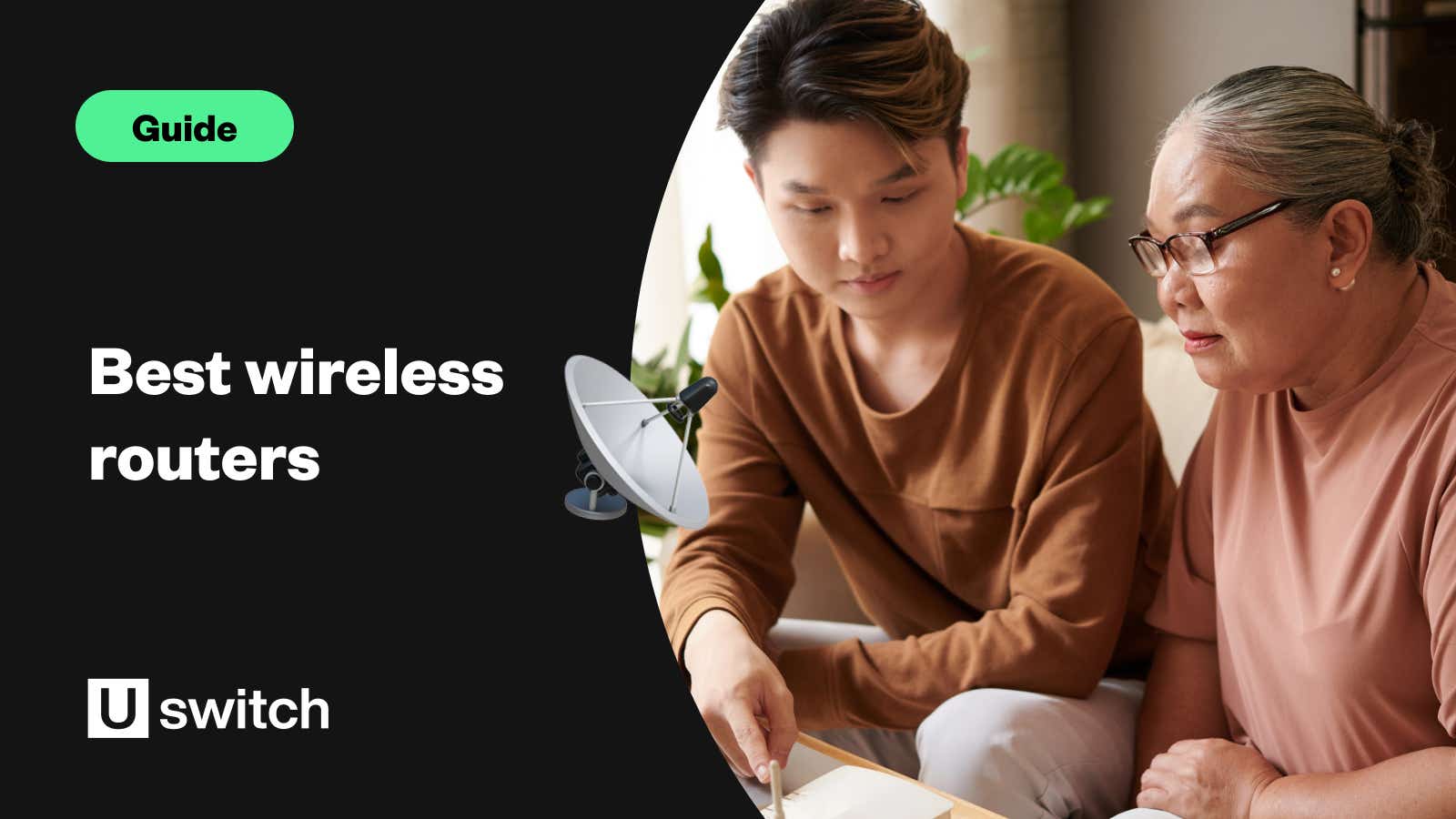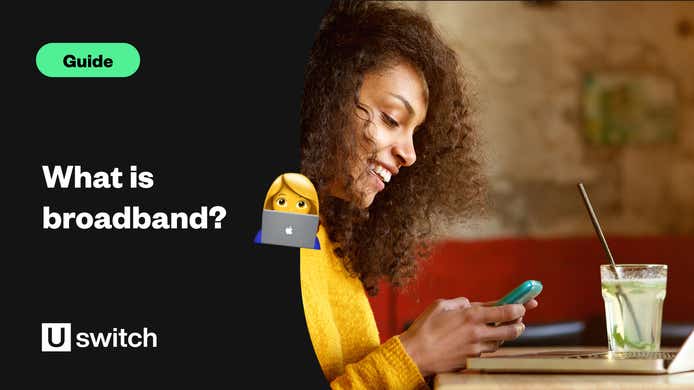With the exception of mobile internet, when people talk about 'wireless broadband', they usually refer to internet with Wi-Fi. In other words, broadband packages allow you to wirelessly connect to the internet.
Nowadays, all recognised broadband providers include wireless routers in broadband packages as standard. However, it could be worth buying a new one if it offers better security, a longer signal range, or greater capacity than your existing router.
The new generation of free wireless routers is also sleeker, easier to install and better designed than the previous version. They also look a lot nicer than older versions, so they shouldn't be too much of an eyesore in your home.
What are the best wireless routers?
As is often the case with technology, a lot of jargon is involved with wireless broadband, which can be very off-putting for people new to it.
We've made a list of the most common terms, best practices and wireless standards to help clear things up.
What is the best broadband router for me?
There isn't much difference between the free routers provided by providers, but they can vary depending on the type of broadband you have.
You might get a less advanced one if you have a slower copper ADSL deal of around 10Mbps, and you might get a more advanced one if you opt for an ultrafast deal of 500Mbps+. Most people right now have a superfast deal with speeds roughly between 30 and 70Mbps, and the quality of these routers usually falls between the above two types.
Best router for fibre broadband
If you choose fibre broadband, full-fibre broadband or Virgin Media's cable broadband, the router your provider gives you will usually be of the highest standard that a free one can be.
You have the option to pay extra for a third-party one that performs a lot better, but it would only really make a difference if you're an extremely heavy internet user, a competitive gamer, or knowledgeable of the technology enough to get the most out of it.
Is the best broadband router worth it?
Do you live with lots of internet users? Are there lots of electronic devices like computers, smartphones, laptops or tablets usually connected to your Wi-Fi? Is your house big or multi-storey? Depending on your answers, getting a new router may be a waste of money, or it may improve your connection.
If your answer to any of the above questions is yes, getting a good wireless router is a smart idea. Plus, if you need to connect a wired internet cable for any of your devices, most have a few ethernet ports in the back to get you online.
However, remember that seeking the best wireless router will likely involve paying for a third-party one rather than any of the routers a broadband provider supplies for free. The free routers that come with each of the major broadband providers will always be good enough for most people.
Find unlimited broadband deals on Uswitch.
Sign up for our latest broadband offers and expert advice
Get more expert insights, browse our latest exclusive offers and find money-saving deals from Uswitch.
What are the different types of wireless routers?
The first ever wireless standard was called 802.11, but this needed to be revised as they got better, and the letter added referred to the speed they max out at.
B routers can handle download speeds of up to 11Mbps, G routers can take speeds of up to 54Mbps and an N router can hit over 100Mbps. For example, a router that says 802.11n can support speeds of up to 100Mbps.
Most new wireless routers nowadays are 801.11ac, also known as Wi-Fi 5. This is capable of withstanding broadband speeds much higher than most UK households can currently get (around 866Mbps).
But we're also starting to see the introduction of 802.11ax, or Wi-Fi 6. Not only can it allow download speeds up to 3.5Gbps, but it will also allow for many more devices to connect to it without clogging up the channels. As a result, it's set to be a game-changer for large venues like stadiums and airports.
What's a channel?
On your router configuration page, you may see something that talks about wireless channels. Each channel has a spectrum, and it's what the signal broadcasts on. If lots of people are using the same channel, it can get congested.
Channels 1, 6 and 11 can be reached through the 2.4GHz band on your router. They are usually the best for the UK because they have the highest frequency ranges, which makes them very popular and more likely to get congested. If you notice slow download speeds, you can try to change it to something that fewer people use.
Most modern routers also offer a 5GHz band now, which contains a much wider range of channels from 36 all the way to 165. You could switch to this band if you're noticing your Wi-Fi speeds are lagging due to demand.
What do WEP, WPA and WPA2 mean?
These are different types of security keys for your wireless connection, but some are better than others. WEP is the weakest, and you should avoid using it. Always use the highest security possible. WPA is okay but WPA2 is much, much better. If you can, add MAC address filtering.
What's MAC address filtering?
A MAC address is a unique code that identifies your network adapter. It is NOT the same thing as a MAC code, which you used to need when switching your broadband provider.
A MAC address will look something like 00:4F:6G:00:EE, and it will be 100% unique to you. No other device in the world will have it, and anything that connects to the internet has to have one.
When you set up your router, you can tell it to only allow connections from specific MAC addresses, meaning that you have to add them individually otherwise the device can't connect, even if it has the password.
Browse our range of wireless broadband-only deals
Choose between dozens of broadband deals on Uswitch.
Which broadband provider has the best wireless router?
Every broadband provider will send a Wi-Fi router to all of its new customers. If you get a basic ADSL package, you can expect a simple router that does the job of connecting you to the internet and very little else.
However, if you sign up for fibre-optic broadband, you can expect a better model with more features. Here are the routers some providers are offering.
BT Smart Hub 2

The second generation of the BT Smart Hub is available to customers who sign up for a BT Superfast Fibre Broadband package.
Like its predecessor, the BT Smart Hub 2 is one of the most advanced Wi-Fi hubs available, featuring seven antennas to access a bigger range of Wi-Fi signals than any other ISP's router. Like many modern routers, the Smart Hub uses both the 2.4GHz and 5GHz bands and uses one or more discs to give you better Wi-Fi coverage throughout your home.
The Smart Hub 2 also has built-in Smart Scan technology, meaning that it will constantly monitor your hub’s connection and switch channels or reboot the connection automatically if it detects a problem.
The same firewall and BT Parental Controls from the company's previous models are also included, so you can restrict web access if needed. There is also a USB port for connecting printers or creating a network by using a USB dongle.
Virgin Media Hub 5

The Hub 5 is Virgin Media's latest router, supporting dual-band wireless channels and the latest Wi-Fi 6 protocol, or 802.11ax.
It was launched in late 2021 and is available only to customers who take Virgin Media's fastest Gig1 plan. Those moving to the Hub 5 from the Hub 3 will notice an improvement in wireless coverage and signal strength, as the Hub 5 has 7 internal antennas, compared to just 5 on the Hub 3.
The latest Virgin Wi-Fi router is a Wi-Fi 6 one, which means it can provide much faster speeds and handle many more devices than most other top-end routers in use right now. In fact, using an ethernet port, it can handle up to 2.5Gbps of bandwidth.
The router is also made from '100% post-consumer recycled plastic', so is a more sustainable option made from previous customers' old routers.
Virgin Media have also quietly added a new router to their line-up. The Virgin Media Hub 5x is a version of the Hub 5 that supports XGS-PON, whereas all other Hubs work with DOCSIS 3.1 or DOSCIS 3.0 connections only.
The Hub 5x is identical to the Hub 5, also offering dual-band wireless channels and supporting the latest 802.11ax Wi-Fi 6 protocol. However, as this router has only been quietly launched, it still seems to be very much in a trial phase, with existing customers sent the router reporting some features aren't quite working yet.
Sky’s Broadband Hub and Max Hub

Sky's Broadband Hub router is still the router you'll get as standard with any Sky Broadband deal if you don't choose the Sky Max Hub add-on to go with it. The main feature offered by the Sky Max Hub is its ability to connect with devices using the latest Wi-Fi 6 technology.
The new Sky Max Wi-Fi Guarantee, guarantees speeds up to a minimum of 25Mbps throughout your home. 25Mbps is enough to stream in 4K, which is among the most taxing tasks commonly found in the home these days when it comes to Wi-Fi speed.
The Sky Wi-Fi Max add-on also offers up to three Sky Max Pods, designed to marry to the router and boost your signal throughout your home. Compared to its predecessor, Sky Broadband Boost, you'll be paying £7.50 per month on top of the price of the broadband package of your contract.
TalkTalk Wi-Fi Hub

TalkTalk has invested heavily in its Wi-Fi Hub, ensuring that its service is just as good as the other major broadband providers. The Wi-Fi Hub is supplied with TalkTalk's Ultra Fibre Optic (900 Mbps+), Fibre 500 and Fibre 150 packages.
Like BT, TalkTalk’s Wi-Fi Hub has seven antennas allowing for greater connectivity even at busier times, switching signals between 5GHz and 2.4GHz to get you the most reliable connection.
It does this by using AC standard Wi-Fi and checking where your AC-compatible tablet, smartphone or laptop is. It can then switch to a faster signal without you noticing any loss of service.
It uses Smart Wi-Fi tech to continually check your network connection as well as its own performance and automatically downloads and installs firmware updates. TalkTalk has also included a handy USB port for connecting dongles and other web-connected devices such as printers and hard drives, as well as four Ethernet ports.
One of the biggest appeals of the TalkTalk Hub is that its sleek design means you won’t have to hide it behind furniture or in cupboards. Having it proudly on display will also mean that its signal will be less interrupted and should reach throughout your home with ease.
Visit the Uswitch wireless broadband comparison page for our best deals from UK providers.
Compare our best broadband deals
Search on Uswitch to find the right broadband package for you.




